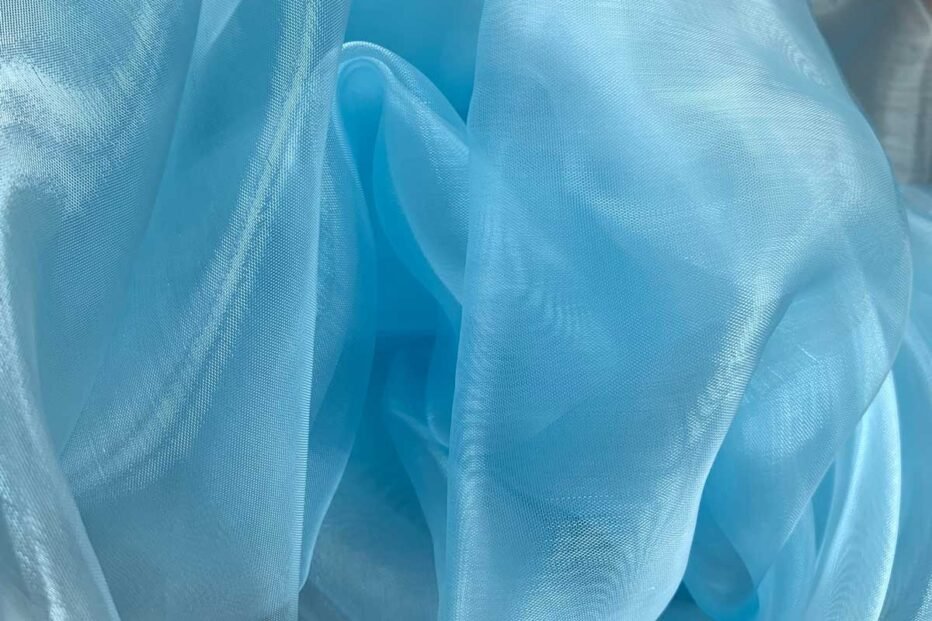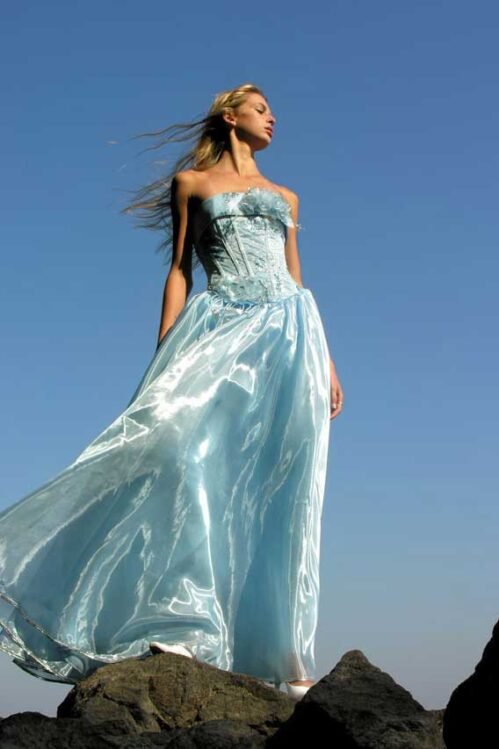Apart from silk, synthetic fibers such as nylon and polyester can also be used to make organza. Compared to the original silk, synthetic fabrics are a bit more durable. However, the fabric itself is extremely delicate and is easily prone to tears and frays.
Common Applications
Gowns, Bridalwear, Lingerie, Veils, Gift bags, Curtains, Home Decor

Description
A supportive, sheer, lightweight fabric often used for bridal dresses
Organza is a lightweight, sheer, plain-woven fabric that was originally made from silk.
The material can also be made from synthetic fibers, primarily polyester and nylon. Synthetic fabrics are slightly more durable, but the fabric is very delicate and prone to frays and tears.
Organza is also characterized by very small holes throughout the fabric, which are the spaces between the warp and weft thread in the plain-weave pattern. The quality of organza is defined as the number of holes per inch—more holes indicate better quality organza. Organza is extremely popular for wedding gowns and evening wear, as it has a shimmery and translucent quality which creates decadent silhouettes.
Background
Story
Like most silk fabric, silk organza fabric originated in China, where silk was first cultivated. Organza was traded along the Silk Road, the trading route from China to Europe, and production spread around the world.
China remains the biggest producer and exporter of organza today. There are several organza weaving mills along the Yangtze River, particularly in Zhejiang province. India is also a large exporter of organza, where a stiffer type of organza is produced in the Bangalore region. France and Italy produce very high-quality organza.
Manufacturing
The weaving process for organza is very complicated and precise and, as a result, most organza is still woven by hand. It can be made by machine, but machine-made organza is compromised in quality.
Twisting the yarn. After the filament fibers—long, continuous strands of either silk or synthetic material—are produced, two single fibers are twisted tightly in opposite directions to form the yarn.
Treating with acid. Before the yarns are woven into a fabric, they are combed and treated with acid. This increases the material’s stiffness, an important quality of organza. Sometimes, synthetic fibers don’t need to be treated this way, as they are often naturally stiff.
Weaving. The yarns are woven together using the plain weave method, where the warp and weft threads are woven over and under each other in an equal ratio forming a criss-cross pattern.

Expertises
Characteristic
- Lightweight
- Durable, remains strong when wet
- Transparency
- Thinness
- Sheerness
- Stiffness
Extra Long Staple
Organza is a fixture in the formal wear arena, but it has many uses in home design and costuming as well.
Evening wear. Organza is often layered over more opaque fabrics like satin or silk to create an added dimension and shine for evening gowns, prom dresses, and more. Since the fabric is transparent, designers can use many layers of organza to create a sculptural dimension. Organza is also used as an overlay for shawls or dresses.
Bridal gowns. Organza is used for bridal wear, including wedding gowns and bridesmaid dresses, as the shiny, smooth material creates soft, full silhouettes thanks to the stiff drape and structure. The fabric is also often used for bridal veils.
Home decor. Organza is a very decorative fabric, and it is often used for sheer curtains and table runners. It can also be used for event decoration, like accessories for seating, aisle runners, and wedding arches.
Bags. Organza bags are popular for small, drawstring pouches to carry accessories like earrings and necklaces.
Costumes. Organza is very popular for stage costuming, particularly dance outfits like tutus and skirts thanks to the beautiful flow and the way they catch the stage lighting.
How Is Organza Fabric Used?
One of the most common applications of Organza in the West is in wedding dresses. These types of dresses often have numerous folds and fluffy areas that are created with sheer fabrics, and organza is a premier choice for these areas. In most cases, organza for wedding dresses is dyed bright white, but it may also be dyed in a number of other colors.
This fabric is commonly used in evening wear, which also frequently emphasizes ruffles and complex folds. One type of evening wear in which organza is especially popular is called an “overlay,” which is a type of shawl that is put on top of a dress or another type of garment. Overlays commonly bear complex patterns that are brightly colored.
Organza fabric may also be used in stage costumes, and it is commonly used in underskirts and specialty dancewear like tutus. Beyond the world of apparel, this type of fabric may also be used to make curtains, lampshades, or other forms of interior decor.
Where Is Organza Fabric Produced?
Being a silk fabric, the predominant area of manufacture for organza used to be East Asia. Various cultures in modern-day India and China produced silk thousands of years ago, and this fabric is still widely produced in these Asian nations. Silk was seen as such a valuable commodity that an entire trading route sprang up due to its existence, and the only organza to be found in Europe during the Middle Ages and Renaissance periods came down the Silk Road.
Social
12k followers
30k likes
Youtube
22k subscribers
8k followers
Have a project in mind?
If you have a great idea, reach out to me. Whether it is a small or big project, I will listen first and get back to you with a plan.

